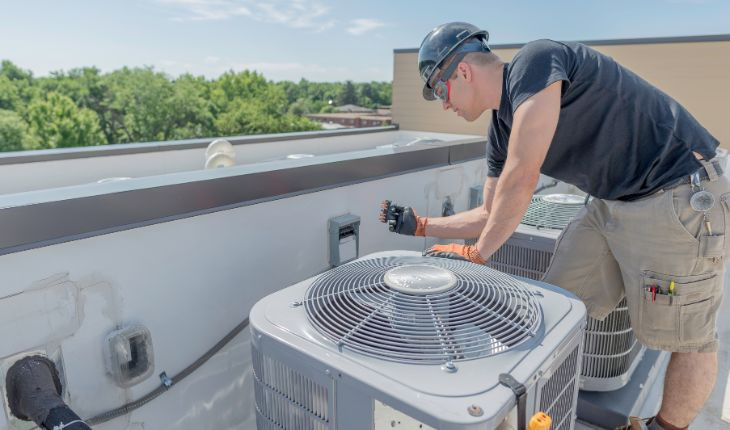Smart HVAC Solutions for Comfortable and Efficient Living
- Sophia Grace
- Jul 21
- 4 min read
In the modern world, comfort is not a luxury—it's a necessity. Heating, Ventilation, and Air Conditioning, or HVAC, forms the invisible backbone of our indoor environments, whether in homes, offices, hospitals, or large commercial buildings. These systems do much more than just adjust the temperature; they regulate humidity, improve air quality, and contribute to energy efficiency, making every breath indoors cleaner and every moment more comfortable. As lifestyles and architectural designs evolve, HVAC systems have transformed to become smarter, more efficient, and more adaptive to changing needs.

Today’s HVAC systems are a fusion of engineering brilliance and digital intelligence. They can detect occupancy, adjust settings based on weather patterns, and even be controlled via smartphone apps. With people spending more than 90% of their time indoors, especially in urban areas, the importance of well-designed and properly maintained HVAC systems cannot be overstated.
Expert Market Research: Decoding Trends in Saudi Arabia HVAC
According to Expert Market Research, the demand for advanced climate control systems is shaping new trends in the Saudi Arabia HVAC industry. With the Kingdom’s extreme climatic conditions and its rapid infrastructure development, the region is witnessing a significant shift towards smart and energy-efficient HVAC technologies. Expert Market Research points out how government regulations promoting green buildings and energy conservation have spurred innovation in HVAC system design. The adoption of solar-powered HVAC units and IoT-integrated solutions in both residential and commercial projects demonstrates how data-driven insights are guiding growth in Saudi Arabia’s HVAC sector. These insights enable engineers, architects, and developers to implement climate-adaptive systems that cater to the unique environmental challenges of the region.
Why HVAC Is More Than Just Air Conditioning
It’s easy to mistake HVAC as just another home appliance, but it is in fact a full ecosystem designed to maintain indoor environmental health. In colder regions, HVAC systems provide efficient heating without drying out the air. In humid or hot climates, they reduce moisture and circulate clean, filtered air, creating a safe and healthy atmosphere.
More importantly, these systems have a direct impact on human health and productivity. Poor ventilation or fluctuating indoor temperatures can contribute to fatigue, allergies, or even serious respiratory issues. With the right HVAC setup, spaces can be transformed into zones of wellness, where temperature, humidity, and air purity work in harmony to support better living.
In workplaces, optimized HVAC systems enhance employee performance by maintaining ideal thermal comfort and air quality. In hospitals, HVAC ensures sterile, temperature-controlled environments essential for patient care. Even in data centers, where overheating can lead to catastrophic failure, HVAC systems act as critical safeguards.
Saudi Arabia HVAC: Adapting to the Heat with Innovation
Saudi Arabia, known for its scorching temperatures and rapid urbanization, relies heavily on HVAC systems for everyday life. In cities like Riyadh, Jeddah, and Dammam, where summer temperatures can exceed 50°C, HVAC is not a luxury but a lifeline. The Saudi Arabia HVAC landscape is unique due to its focus on high-performance cooling systems that can handle the intense climate while remaining energy-efficient.
One of the notable shifts in this region is the move toward sustainable HVAC technologies. New developments such as NEOM and the Red Sea Project are emphasizing eco-friendly infrastructure, incorporating smart building systems with adaptive HVAC units powered by renewable energy sources. With a growing interest in environmental responsibility, Saudi Arabia is quickly becoming a regional benchmark for climate-responsive HVAC engineering.
The rise in smart homes and luxury living spaces has also pushed for personalized HVAC systems that offer individual zone control, seamless integration with home automation systems, and remote access through mobile devices. This evolution reflects a future where comfort, technology, and sustainability go hand-in-hand.
Smart HVAC: The Age of Intelligent Climate Control
Modern HVAC systems are rapidly shifting from reactive to proactive. Artificial Intelligence and the Internet of Things (IoT) now play key roles in managing HVAC performance. Smart thermostats learn user preferences, detect occupancy patterns, and adjust temperatures accordingly. Predictive maintenance features allow homeowners and facility managers to spot problems before they become costly repairs.
Energy-efficient HVAC technologies, such as variable refrigerant flow systems and geothermal heating and cooling, are not only reducing carbon footprints but also helping in long-term cost savings. Smart sensors constantly monitor indoor air quality and adjust airflow to maintain a healthy environment, automatically adapting to outdoor weather conditions and usage trends.
For commercial buildings, Building Management Systems (BMS) offer centralized control of HVAC alongside lighting and security systems, creating cohesive energy strategies that improve operational efficiency. It’s this synergy of automation and customization that is defining the future of HVAC.
Building a Greener Future Through HVAC
As global temperatures rise and cities expand, the role of HVAC in achieving sustainable development goals becomes even more vital. Green HVAC designs emphasize the use of renewable energy sources, recyclable materials, and systems that minimize water and energy usage. Certifications such as LEED and WELL now consider HVAC performance as a core metric of sustainable building practices.
In both developed and developing regions, there's a growing emphasis on retrofitting older buildings with modern HVAC systems to improve energy efficiency. Public institutions, schools, airports, and residential complexes are all undergoing transitions that reflect a wider movement toward environmental responsibility.
Breathing Better, Living Smarter
HVAC systems, once considered background technology, have taken center stage in our pursuit of health, comfort, and sustainability. They’re not just about keeping us warm in winter or cool in summer—they’re about shaping the environments we live, work, and grow in.
From the sun-drenched skyscrapers of Saudi Arabia to the climate-controlled offices of metropolitan hubs around the globe, HVAC systems are adapting, innovating, and transforming. As technology continues to advance and global needs evolve, one thing remains certain—when it comes to comfort and clean air, HVAC is the invisible force that makes life more livable.









Comments